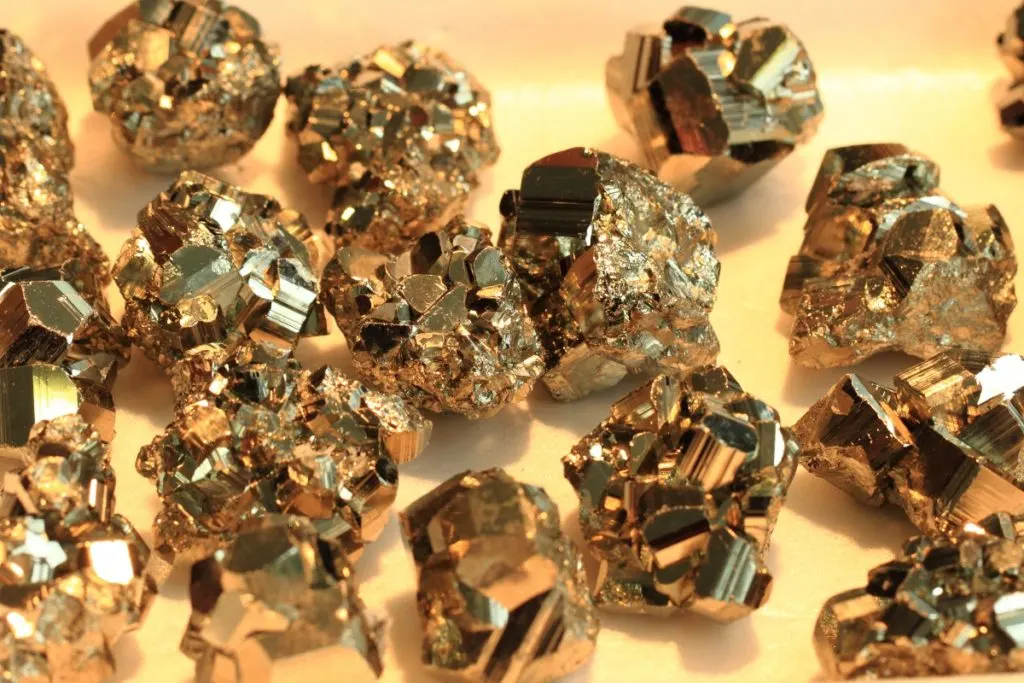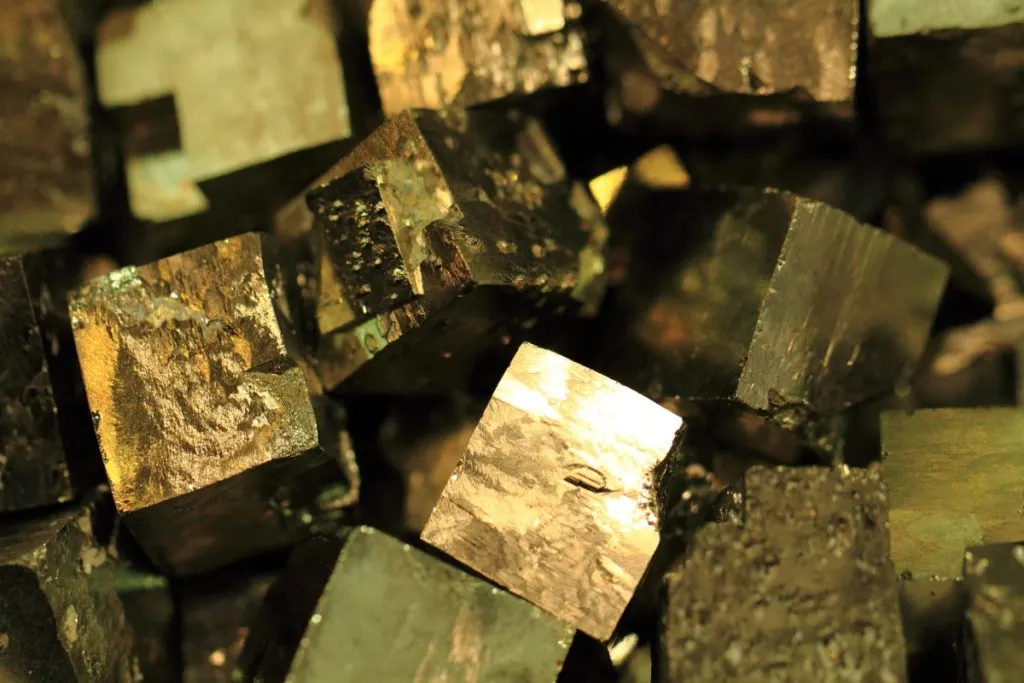As an Amazon Associate, I earn from qualifying purchases with no additional costs for you.
Pyrite value can vary dramatically depending on the types of samples. Pyrite is a ubiquitous mineral, and mineral collectors love it for its gold color and incredible form of crystals. As a result, it is commonly known as fool’s gold, but true connoisseurs prize pyrite as more than just a gold-resembling mineral.
Pyrite’s price varies from $5 to 10 for common tumbled stone. Still, it can reach several hundred for samples from well-known locations or pyritized ammonites. The main factors of pyrite value are crystal habitus and their size, as color does not vary much in pyrite, and crystals are always opaque.
Pyrite differs from other common minerals a lot as it is a representative of the sulfides mineral group. People mainly collect attractive silicates, carbonates, phosphates, and oxides.
However, pyrite shows a lot of distinctive properties, such as metallic luster, opaqueness, and spectacular crystal forms silicates don’t have. Even being readily available, some pyrite samples can reach hundreds of dollars. This article will show that pyrite is not only a fool’s gold.

If you are interested in checking out the best books about rock and minerals identification you can find them by clicking here (Amazon link).
Is Pyrite Worth Anything
Pyrite is well-known as fool’s gold because of its brassy yellow color and metallic luster. It forms in a variety of geological conditions. It can be found as an accessory mineral in many rocks.
Even being available on any mineral show for a few dollars only, some ideal pyrite cubic crystals from a known locality are valuable materials and can reach several hundreds of dollars per sample. In addition, pyrite creates spectacular disk-shaped mineral concretions that are highly valuable.
Pyrite is the most common iron sulfide mineral with the formula FeS2. Atoms are arranged in an isometric cubic crystal system that results in pyrite crystals’ cubic and octahedrons appearance. Pyrite is always opaque and has a bright metallic luster when fresh.
As a mineral, pyrite can be found in almost any type of rock (magmatic, sedimentary, and metamorphic rock). It can be primary – crystallized from original magma and secondary mineral – created from diagenesis processes.
The various mineral formation environments result in different forms of pyrite occurrence. So the genesis of pyrite dramatically influences the state of pyrite occurrence, whether it will be excellent idiomorphic crystals or solid masses. These two groups worth drastically different.
We can differentiate 5 forms of pyrite which command different worth categories. These are
- Idiomorphic crystallographically perfect crystals.
- Pyrite “suns” or “miners’ dollars.
- Pseudomorphs after fossils
- Common massive pyrite
- Samples from well-known mineral localities.
Pyrite samples we used to see on mineral shows and online platforms refer to the less valuable group. This pyrite crystal masses can be tumbled and command prices less than $10 for tumbled stone. This group is the most common and represents more than half of the pyrite market.
Pyrite “suns” and pseudomorphs after fossils (pyritized ammonites) are the next price level. But, again, depending on size and quality can range between dozens to hundred dollars.
Perfect sharp pyrite crystals have a similar price range compared to the previous group. Still, samples from well-known mineral localities and of museum quality are worth hundreds to first thousand dollars.
TIP: The metallic luster looks the same as it sounds. Mineral faces like the pyrite one look like polished metals and are very reflective. Find out more about mineral’s luster in the article below:
Step-by-Step Guide: Testing Mineral’s Luster like a PRO
What is The Value of Pyrite (Main Factors)
Pyrite value factors are strikingly different from universal properties like color, clarity, transparency, texture, pattern, or craftsmanship common to other minerals. Pyrite color doesn’t differ from sample to sample.
It is always brassy-yellow and opaque, unlike many silicates (quartz, tourmalines, garnets). Pyrite is rarely faceted or carved, so there is no additional value for craftsmanship. All these properties are unchanging and cannot influence pyrite value.
The main factor of pyrite value is the crystal habit, the form of occurrence (pseudomorph), and the source of the mineral. Therefore, crystallographically correct cubes, octahedrons, not disrupted crystal faces, and edges of pyrite crystals that originate from well-known localities are the most valuable.
The following factors can help us to decide whether a pyrite sample in front of us is valuable or not. They are
- Crystal habit
- Pyrite pseudomorph after fossils
- Source of mineral (location)
Crystal Habit
The crucial factor is crystal habit and how close to the crystal’s perfect crystallographical form the mineral sample is. Pyrite crystals occur in cubes, octahedrons, and pyritohedrons.
The fascinating thing about pyrite is that some ideal pyrite cubes are readily available. Pyrite cubes look so unrealistic that it is hard to believe that nature could create ideally right angles and facets without human assistance!
Another spectacular form of pyrite occurrence is the pyrite “sun,” sometimes called “miners’ dollars.” These are disk-shaped mineral concretions of pyrite radiating from the center to the rim.
The mineral disks range from the size of a small coin to a dinner plate but are commonly about 3 to 4 inches (7,5 – 10cm) in diameter.
Also, pyrite occurs in inter-grown, massive, granular, globular, and stalactitic forms. Massive pyrite is extremely common and can be sold as an aggregate of crystals or druses on mineral shows.
Typically massive pyrite is tumbled to produce smooth gold-colored stones. Massive pyrite is less valuable, and its prices rarely exceed dozens of dollars.
TIP: If you want to find pyrite near you in the U.S., the best thing to do is to know exactly how it forms and in which environments. Find out more in the article below:
Where to Find Pyrite: Best Environments & Locations in USA
Pyrite Pseudomorph After Fossils
The great thing about pyrite is that it can inherit a form of the instinct mollusk, creating stunning pyritized ammonites. The organic material of ammonites is entirely replaced by iron sulfide. The process occurs in marine sediments, commonly black shales, in a reducing environmental condition, without any oxygen available.
When one material replaces another, but the initial form stays intact, the result is called pseudomorph. Pyrite pseudomorphs after ammonite are highly valuable and can cost from 30 to hundreds and thousands of dollars depending on the size, rarity, and degree of preservation.
BTW: Do you want to know more about rock and mineral identification? The books listed below are the best ones you can find on the internet (Amazon links):
- Smithsonian Handbooks: Rocks & Minerals
- Gemstone & Crystal Properties (Quick Study Home)
- Ultimate Explorer Field Guide: Rocks and Minerals (National Geographic Kids)
Source of Material
The source may seem unimportant for pyrite as a ubiquitous mineral. But there is a unique locality of pyrite, samples from which are highly prized worldwide.
The world-famous specimens of shiny near-perfect pyrite cubes come from Navajun, La Rioja Province, Spain. Incredibly perfect pyrite cubic crystals reach up to 20 cm sides.
Combinations and intergrowths of the crystal create spectacular extraterrestrial forms and resemble spaceships. Pyrite cubes are nestled in a marl host rock of white color which makes a perfect contrast to mirror-bright and sharp crystals.
TIP: All ores are minerals, but not all minerals are ore. Do you know the difference between these two geological terms? Find out the answer in the article below:
Main Differences Between Ore and Mineral You Should Know
How Much is Pyrite Worth per Pound, Ounce, Kg, Gram & Carat

Pyrite is a widely spread mineral, and prices for tumbled stones rarely exceed $10. Samples of massive pyrite crystals cost around $20 – 80. The best collection specimens cost up to $600 – 800. The average per pound price for rough is $10 – 20. Pyrite price is rarely based on its carat weight.
Here is a table with approximate prices for different values for you to know the possible range of price tags.
| Unit | Pyrite Price |
|---|---|
| per carat | less than 1 cent *commonly not used for pyrite pricing |
| per gram | $0.02 – 0.04 |
| per ounce | $0.5 – 1.2 |
| per pound | $10 – 20 |
| per kilo | $20 – 100 |
Pyrite is an opaque mineral with a metallic luster. Even being a hard mineral (6 – 6.5 on the Mohs scale), it is pretty unstable in our oxidizing environment.
As a result, pyrite can be destroyed by water and household chemicals. Because of its durability issues, pyrite is unsuitable to be used as a gem and faceted stone. This is the reason why pyrite weight is seldom expressed in carat.
Pyrite prices are commonly set for the mineral sample or a tumbled stone parcel. Weigh for rough material is primarily expressed in pounds and kilos.
TIP: Pyrite is believed to be quite a common mineral, however, pyrite fakes can be sometimes spotted. Check out the differences between real and fake pyrite in the article below:
Real vs. Fake Pyrite: Focus on These 7 Differences
Where to Buy Pyrite
As pyrite is a ubiquitous mineral that can be formed in magmatic, metamorphic, and sedimentary rocks on any continent, there is plenty of natural pyrites, and there is no need for fake pyrite production. So in the case of pyrite, it is safe to buy it even on online platforms.
Mineralogists recommend buying mineral samples of pyrite on mineral shows where you can examine a piece on your own. Massive pyrite and tumbled stones can be safely purchased online. To be ensured in purchasing a highly valued collection sample, ask for the name of the sample’s locality.
Conclusion
Pyrite is a widespread and readily available mineral. The price for tumble stones rarely exceeds $10. Typical massive pyrite crystals cost around $20 – 80. The average per pound price for rough is $10 – 20. Some rare beautiful mineral specimens like perfectly formed crystals or pyrite “suns” reach the value of several hundred of dollars.
Pyrite value factors are strikingly different from other minerals because of pyrite’s physical properties. For example, pyrite is opaque, has a metallic luster, has no texture and color variations, and is hardly ever carved or faceted. That is why classical value parameters like color, transparency texture, and craftsmanship are not used to evaluate pyrite’s value.
Pyrite’s main value factors are
- Crystal habit. The more crystallographically correct and not distorted crystals are, the higher the value.
- Pyrite pseudomorph after fossils. This is a pretty rare factor, but pyritized ammonites are highly valuable.
- Source of mineral (location). When the location where the mineral sample comes from is known (for example, Navajun, Spain), the mineral sample collection potential favorably increases.
TIP: You need to know something about how gold deposits occur to understand which rocks to look for when prospecting. Check out the complete guide in the article below:
5 Rocks You Need To Look For When Gold Prospecting (+ Why)
